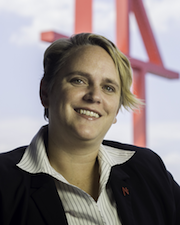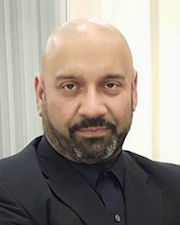Questioning the Calculations |
College Promise Programs | Donate! 


What’s AHEAD Commentary [February 2017]
To join the discussion on these commentaries, please visit our Facebook page:
https://www.facebook.com/PennAHEAD
Undocumented Students and Sanctuary Campuses
In our latest What’s AHEAD poll, we focused on issues of undocumented students, sanctuary campuses, and immigration policy. Below you will find the framing commentary from Penn AHEAD’s Executive Director, Dr. Matthew Hartley, and two Penn GSE alumni and leading scholar-practitioners: Dr. Melanie Corn (Columbus College of Art and Design) and Dr. Victor Aloyo (Princeton Theological Seminary).
What do we stand for?
 Dr. Matthew Hartley
Dr. Matthew Hartley
Executive Director, Penn AHEAD and Associate Dean for Academic Affairs,
Graduate School of Education, the University of Pennsylvania
What a difference a week makes. When the poll was conducted, the fallout of the executive order was unclear. Most respondents felt that college and university leaders should assess the institutional impact of the Executive Order (75%) and share concerns with federal officials about its implications (77%). Less than half (46%) believed the Order should be publicly opposed and few (11%) felt institutions should revise their policies. These responses are understandable and predictable. We’re comfortable generating data and conveying findings. But institutionally we are conservative; we avoid risks. The responses are also disappointing. While half of respondents (51%) felt that sanctuary campus declarations would create positive outcomes for undocumented students, two thirds (67%) worried they could lead to the loss of federal funding for student aid and/or research. In other words, why risk the loss of funds by speaking out or protecting undocumented students, even if we believe such actions would have positive outcomes?
Declaring an institution a sanctuary campus is a low bar. It means not openly sharing student information with any immigration and customs official who asks for it. It means telling campus safety not to actively seek information about the immigration status of students they interact with. It means not allowing federal immigration officials into private areas on campus (for example, residence halls) without a warrant. The notion that such meager steps would lead to wholesale federal divestment in higher education is fanciful to say the least. While the designation would provide scant protection if immigration laws go sideways, the sanctuary campus as an ideal has been a powerful signal on many campuses. Even on campuses where relatively few students might be affected a sanctuary campus declaration says: All students are important.
On February 9, 2017, the U.S. 9th Circuit Court stopped President Trump’s Executive Order on immigration. Many have argued it is unlawful and unconstitutional. It is also discriminatory, and likely violates the Establishment Clause by officially favoring Christians and disfavoring Muslims. More importantly, it violates the fundamental idea of the United States as a country of immigrants who come here “yearning to breathe free.” If we, as higher education leaders, aren’t willing to stand up and be counted when such ill-considered orders violate our fundamental values, then what are we willing to stand up for?
“Sanctuary Campus”: the Spirit Trumps the Label
 Dr. Melanie Corn
Dr. Melanie Corn
President
Columbus College of Art & Design
During his first month in office, President Donald Trump signed more than a dozen executive orders, including one temporarily blocking refugees and all immigrants from seven Muslim-majority countries and another denying federal funding to sanctuary cities and increasing deportation of those in the country illegally.
As Trump attempts to fulfill campaign promises, concerns about immigration have clearly dominated much of his early actions and talk. And, although the president has yet to make any official changes to the Deferred Action for Childhood Arrivals program, DACA recipient Daniel Ramirez Medina was detained by immigration agents last week, laying groundwork for the next potential legal battle.
Over the past month, we have also seen widespread opposition to these anti-immigration policies; and within this context, it is not surprising that the latest Penn AHEAD poll shows that higher education leaders believe colleges and universities should support undocumented students and leaders should speak out publicly about the need to support and educate all students regardless of their immigration status or country of origin.
Agreement amongst poll participants ends, however, with the designation “sanctuary campus.” Only 35% of respondents agree or strongly agree that colleges and universities should declare themselves “sanctuary campuses.” The dissonance within the poll is likely caused by the lack of clarity about the precise meaning of “sanctuary campus,” and the fact that, despite the confusion, the term has become a lightning rod in the political polarization of our latest culture wars.
A global campus with undocumented students and Muslim immigrants benefits the U.S. by educating our nation’s diverse workforce, driving innovation and economic development, and spreading American values when international students return home. So, drop the “sanctuary” label if that is most politically prudent, but stand up for your students and speak out against misguided public policies that defy higher education’s fundamental principles of free inquiry, the pursuit of truth, and support for diverse peoples and viewpoints.
Sanctuary Campus: The Need for a Closer Look!
 Rev. Dr. Victor Aloyo, Jr.
Rev. Dr. Victor Aloyo, Jr.
Associate Dean for Institutional Diversity and Community Engagement
Princeton Theological Seminary
One of the grand challenges in society is to eliminate bias, prejudice, stereotyping, and discrimination and their deleterious effects. Issues of diversity and discrimination reflect a long history of persistent gaps in educational, economic, legal, and social outcomes, as well as laws and policies that have dictated or enabled differential treatment. Over the past 50 years, laws and social movements have emerged that have generated consciousness about justice, change, and human rights. In the midst of these uncertain times, institutions of higher education will need to explore their options in providing venues for constructive exploration where voices can be heard from a wide breadth of experiences, as policies and immigration law will undoubtedly change. What will be the impact of such a change and how will it affect the communities where our leaders will be called to serve?
The recent presidential election has caused speculation and concern about immigration issues on campuses throughout the country. Campaign rhetoric has brought much fear to thousands of DACA (Deferred Action for Childhood Arrivals) students, and undocumented employees at institutions of higher education. It is important to note that at this moment we do not know with certainty what to expect from the new administration. It will be ill-advised to make specific predictions and provide advice based on policies, regulations, and statutes that neither have been revoked or are currently in debate. Yet, it is prudent that as institutions of higher education, we become well informed about what is understood about being identified as a sanctuary campus.
The complexities of a designation such as Sanctuary Campus is superficial or cursory to the issues of prejudice that is rampant in our society. What are the critical conditions for moving from exclusion to access to respectful inclusion, and what are strategies for respectfully including people who are different? Critical questions need to be formed and analyzed responsibly given the levels of hatred, bigotry, and discrimination that are surfacing as acceptable forms of behavior.
At this point, it is not clear what direction this new administration will take in regards to these matters. Regardless, the complexities of these issues warrant proactive action via internal and external conversations, institutional policy and protocol review, and, equally crucial, our ability to establish guiding frameworks for action. These guiding frameworks should include the reality that immigrants are resilient and resourceful; like all human beings, immigrants are influenced by their social contexts, and thirdly, our future leaders require intentional course work that can prepare us all to use the lens of culture with the increasingly diverse immigrant-origin population.
To join the discussion on these commentaries, please visit our Facebook page: https://www.facebook.com/PennAHEAD



